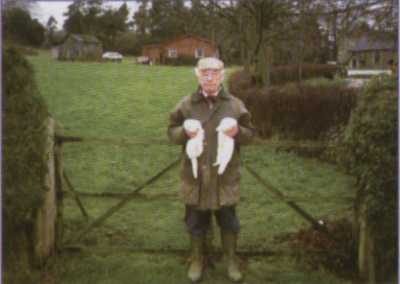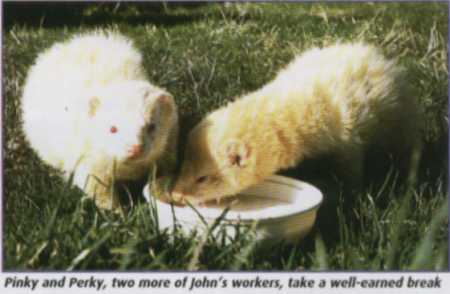Ferreting - A Humane Method of Pest Control
 JOHN BURGESS, a working ferret man for more than 20 years, is a familiar face at ferret shows throughout the Midlands and the North of England. He lives outside Grimsby and works his ferrets across a stretch of North Lincolnshire. Here, he tells Ferrets First why the ancient sport of ferreting is the best way to control Britain's rabbit population.
JOHN BURGESS, a working ferret man for more than 20 years, is a familiar face at ferret shows throughout the Midlands and the North of England. He lives outside Grimsby and works his ferrets across a stretch of North Lincolnshire. Here, he tells Ferrets First why the ancient sport of ferreting is the best way to control Britain's rabbit population.
RABBITS ARE a serious agricultural pest. Crop damage runs into millions of pounds annually and land owners are legally obliged to control rabbit numbers. Of all methods used, I consider ferreting to be as humane as any, and more so than some.
Ferreting is practised by some professional pest controllers but it is mainly done by amateur working ferret enthusiasts, the rabbits caught being either for their own consumption or sold to offset the costs of the sport. One thing is certain, they do not get rich doing it.
Briefly, ferreting is carried out in the following way. Nets are placed over each of the holes in the warren or burrow. The ferret is put inside to bolt a rabbit into the net. The ferreter dispatches the rabbit with one deft movement. Its neck is broken and death is instantaneous.
For successful bolting, the setting of nets should be done quietly, with as little walking about as possible. A small ferret, not strong enough to hang on to a rabbit is preferred.
I find it difficult to explain to the pet owner the pleasure I get from ferreting. There are those who think that necessary pest control should not be a pleasure but a job to be done, not enjoyed.
The act of killing the quarry gives no pleasure, but there is satisfaction in doing it efficiently and humanely.
There is the thrill the first time a six to seven-month-old kit bolts a rabbit and satisfaction as it makes progress to become a reliable and efficient worker by the time it is one year old.
When you hear a bumping noise below ground, and, if the burrow is not too deep, feel the vibration below your feet as the rabbit is hotly pursued and then explodes into the net, there is a rush of adrenaline. I'm not a football fan but I suppose it is like the thrill of a soccer supporter when his team scores a goal.
Ferreting is selective, small wildlife escape through the net mesh and any larger, non-pest, animals caught can be released without harm.
The object is to reduce the rabbit population to an acceptable level, not to exterminate the species.
Generally, the ferreting season starts in mid October and ends in mid March, depending, to some extent on the weather. As soon as baby rabbits are encountered, we stop, not wanting to kill off next year's sport, so there is a conservation element to ferreting.
Sometimes, rabbits will not bolt. There may be dead end tunnels in a warren, into which a rabbit is driven by the ferret. I have seen a queue of rabbits in a dead end tunnel, the last being tucked in a tight ball, with its rear end facing the ferret to prevent a fatal bite to its neck. Accurate work with the locator and quick careful digging will result in minimum damage to the rabbit being attacked by the ferret. As soon as the spade breaks through into the tunnel, the ferret is removed and the rabbit or rabbits swiftly dispatched.
Other pest control methods have disadvantages when compared with ferreting.
Shooting cannot take place in some places for safety reasons. An accurate shot results in an instant death but this cannot be guaranteed. A shot that does not kill may lead to a slow and painful death. Gassing is not selective and other wildlife co-exist with rabbits. It is not effective in dry weather as the soil must be moist for the gas tablets to work. It is also expensive. I know of a 1,700 acre farm that spends more than £1,000 a year on gas. In addition, there are labour costs for two operatives, who must comply with health and safety regulations.
Snaring is not selective. Other wildlife and domestic cats may be caught.
Live cage traps are available but I have tried them without much success. I think rabbits have to be very hungry before they are effective.
 Dogs are use by lurcher enthusiasts and some will bring back live rabbits uninjured but skilful training is required. Dogs cannot always be used because of the risk of accidents.
Dogs are use by lurcher enthusiasts and some will bring back live rabbits uninjured but skilful training is required. Dogs cannot always be used because of the risk of accidents.
To sum up, we must treat the hunted quarry with respect and also remember our own ferrets - rest them when they are tired and maintain their locators well to avoid losing them. Also, avoid dangerous places like fox earths and badger setts. The well being of our ferrets should be our first consideration.
